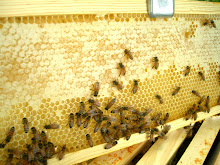With colder weather approaching, it was time to prepare the hives for winter. Last weekend, I inserted an escape screen between the second and third supers in the Apollo hive in order to get the bees out of the top box. I wanted to remove the top box so that the bees would be forced down into just two supers and, therefore, stay warmer in a smaller space during cold weather.


The escape screen, by the way, is a simple but ingenious piece of equipment — bees can leave the honey super through the center hole of the screen, but cannot find their way back. No chemicals or fuming are involved in this method, and the bees stay calm. Normally, bees get very riled up if they think there's even a remote possibility that you're going to rob their honey stores.



While I was putting the escape screen in place, I noticed the bees had been a little more active in recent weeks and had actually stored some honey in the frames of the top super!
This morning, almost all of the bees had exited the honey super. The escape screen had worked like a charm! With Tim's help, I removed the honey super and then put protein patties (made mostly of pollen) into both hives for the bees to have as a winter food source. The hives were humming when I closed them, but it was more of a pleasant buzz than an angry one.
We brought the honey super into the garage, where I assembled a basic honey filtering system. The system consists of two five-gallon pails — the top pail has a fitted nylon mesh bag (similar to cheesecloth) and a sieve-like metal plate through which the honey is strained and then flows into the bottom pail. A spout attached to the bottom pail allows you to easily fill jars with honey.


Using an uncapping knife with a serrated edge, I sliced the cappings and wax off the frame inserts and let everything fall into the top pail of the filtering system. As the honey drips out of the cappings, it's filtered through the mesh bag and drains down into the bottom pail. Maybe tomorrow I'll have enough honey to fill a small jar or two!
The honey is a beautiful light amber color. I thought surely it would taste like clover since there's a lot of that in our neighborhood. However, it has a distinctly tangy, citrusy flavor. It's lovely.
